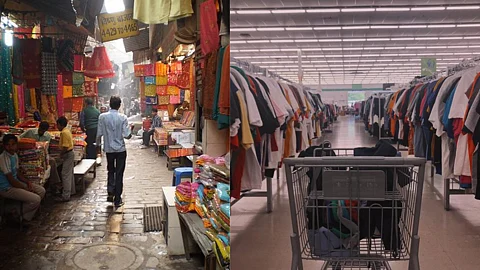
- HOMEGROWN WORLD
- #HGCREATORS
- #HGEXPLORE
- #HGVOICES
- #HGSHOP
- CAREERS
- ABOUT US
- CONTACT US

With the rise of Gen Z in the last decade, thrift shopping has come to the fore in India. While some may perceive it as a Western import, India has a deep-rooted tradition of street shopping and bustling haats where secondhand clothing has thrived for generations.
While thrifting has gained popularity in recent years, it is important to note that the traditional forms of thrifting and second-hand culture in India continue to coexist.
Throughout history, secondhand clothing in India was often relegated to the lower classes and castes. It bore the burden of social stigma, as the upper class abstained from wearing used garments. The division was not merely based on economic disparities but also influenced by notions of purity and class privilege. The elites sought new and exclusive clothing, distancing themselves from the perceived impurity associated with secondhand attire. The upper classes looked down upon this practice, associating it with lower social status and considering it unfit for their own consumption. Thrifting was thus overlooked as a legitimate choice in the realm of fashion and lifestyle.
However, India's vibrant street markets and haats have long been centres of trade for pre-owned clothing. These bustling bazaars facilitated the flow of fashion items, showcasing the resilience of a thrift culture deeply embedded in Indian society. Due to the emergence of thrift culture, what was once considered a symbol of economic limitations has now become a thriving industry and perhaps even a catalyst for change.
There has been a culture of hand-me-downs that is predominant in most cultures, mostly circulated within the family. Hand-me-downs allow families to save money and maintain a connection with their heritage.
Moreover, In India due to the hierarchy of caste and classes, it is always seen as a form of charity of the upper castes towards the lower classes working for them.
So, what changed? What has prompted the recent shift in perception towards thrifting in India?
In India, trends and cultural practices are often shaped and dictated by the upper caste and class, creating a dynamic where their preferences and choices dominate the mainstream. A similar pattern emerged with the rise of thrifting, as upper-caste individuals took the position of trend makers and redefined the perception of secondhand clothing. Although thrifting was historically practised by lower castes and classes and discouraged by the upper classes, it has now been claimed as a proud and sustainable practice by the upper castes.
One of the significant changes brought about by the thrifting revolution is a shift in perception. Thrifting, which was once associated with lower-income segments or considered a last resort, has now become a trend embraced by people from various socioeconomic backgrounds. The stigma surrounding second-hand items has diminished, and thrifting is now seen as a fashionable and sustainable choice.
As thrifting gained recognition globally for its sustainability and eco-conscious nature, upper-caste individuals in India began to embrace the practice. With their social influence and economic power, they started to reshape the perception of secondhand clothing. As trendsetters, they brought thrifting into the mainstream by endorsing its benefits and incorporating it into their own wardrobes. This shift in attitude had a profound impact on how thrifting was perceived in Indian society.
By associating thrifting with environmental consciousness and responsible consumption, they turned it into a virtue and a symbol of progressive lifestyle choices; allowing upper-caste individuals to take pride in their thrifting practices and freeing them from the social stigma it previously came with.
On the other hand, the increasing popularity of second-hand clothes has led to a shift in the industry's dynamics. As independent vintage and thrift stores cater to a more affluent market, prices have risen. This pricing trend presents a significant barrier to access for lower-income earners who rely on the affordability of second-hand items. The industry, once seen as an inclusive alternative, risks excluding those who depend on it the most, thereby widening socio-economic disparities in fashion consumption.
The upper caste's embrace of thrifting represents a reappropriation of a practice historically associated with lower caste and classes. By adopting thrifting and positioning it as a trendy and sustainable choice, the upper caste individuals are claiming this cultural space and asserting their dominance as trend makers. This dynamic reinforces existing power structures, where practices associated with lower castes are often dismissed until they are embraced and endorsed by the upper castes.
While the upper caste's involvement in promoting thrifting has played a crucial role in transforming its perception, it is essential to acknowledge the historical practices and contributions of the lower caste and classes. There is a need for broader representation and recognition of the role they played in popularising thrifting before it gained mainstream acceptance. By acknowledging their contributions, we can challenge the power dynamics and ensure a more inclusive narrative that encompasses diverse voices and experiences.
